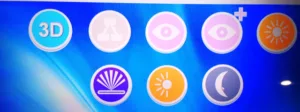We met with RealD in a meeting room at the back of the South Hall at CES to discuss progress on its Intelilight technology. This is essentially an intelligent backlight that can direct light in any of a number of ways to create a range of display solutions. It is based on a unique backlight design that features a Fresnel lens and a folded optical system inside the waveguide, and integrated with 64 addressable LEDs at the bottom. This makes the device capable of a number of effects (see photo of icons for some of these modes):
- Glasses-free S-3D – Using eye tracking technology, the BLU is used to direct the left eye image at 60 Hz per eye, then the right eye image at the same rate with no trade off in resolution using a 120 Hz panel. Optimal 3D viewing is tailored to the viewer’s distance from the screen. This mode can even support 3D-in-2D windowing.
- Dual View – Separate images are flashed at 60 Hz and directed to the left and right side of the display. Key applications include center console displays in cars so the driver and passenger can see separate, full resolution images, again requiring a 120 Hz panel.
- Privacy filter – narrow the viewing cone by managing the LEDs in the backlight. The Privacy Plus mode actually inserts a negative image in the ‘wings’ of the display to enhance the privacy.
- Sunlight readable – Increases light to the driver while reducing to passenger in sunlight conditions – or the reverse.
- Night Mode – Reduces light to the passenger while maintaining brightness for the driver.
RealD reports considerable engagement with customers on this technology with the automotive applications in the “late development phase.” They also report that the first laptop that has a RealD privacy filter solution, replacing a 3M film, may be here soon as well.
RealD has also developed an updated face tracking technology. FaceSense again focuses on monitoring drivers to improve safety and security by monitoring head and gaze orientation as well as blink detection. The system can then determine the alertness of the driver or passengers, even in the back seat. It is a software solution using standard cameras that tracks 68 facial landmarks.
A solution they call SocialEyes is aimed at the video conferencing market. Everyone who has done a web-based video conference knows that you can’t look at your screen and look at the camera at the same time. This means you only get eye contact when the person looks at the camera and away from their screen. RealD has solved this problem.
SocialEyes is a software solution that takes the web cam image and identifies the eyes of the person (and captures an image, we suspect) when they are looking at the camera. When they return their gaze to the screen, the software inserts the image of the eyes looking at the camera. The result – you can continue to monitor information on your screen while the other person sees you as if you are making eye contact with them.
In the demo I received of this, you could see it was definitely working (left image is as captured looking at the web cam mounted below the monitor and the right side is the corrected view), but I would have to spend more time to really know if the effect was valuable or just creepy. – CC



